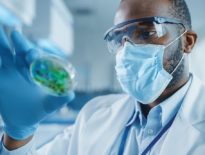
Big pharma leases such as Takeda’s full-building commitment at BioMed Realty’s 585 Kendall in Cambridge contributed to another strong quarter of lab absorption in Greater Boston. Image courtesy of CBT Architects
The Boston metro has been a leader in life science research for decades, and the attention that the COVID-19 pandemic drew to the industry propelled the area even more over the last few years.
Although that upward projection continued through the first half of 2022, a few headwinds are mounting.
The public biotech market has seen a downturn since early 2021, and the private markets have started to feel the pinch. After a record year in venture capital funding in 2021 ($12.4 billion), the first half of 2022 ($3.7 billion so far) has seen a decrease of private companies in Massachusetts receiving funding. This has caused new company formation to slow, and many private firms are being forced to prioritize their cash reserves. The funding levels in 2022 resemble those of 2020 ($6.3 billion), still strong historically.
Even with the uncertainty on the horizon, Boston has remained the nation’s epicenter of biotech and pharmaceutical research. In the second quarter of 2022, the market recorded over 2 million square feet of net absorption, while rents were the highest in the country, and vacancy sat at sub-1.5 percent. East Cambridge was home to the nation’s two largest leases with AstraZeneca and Takeda signing leases in new build-to-suit projects, both over 550,000 square feet. Vertex was the third-largest lease signed nationally during the second quarter for over 340,000 square feet in the Seaport District submarket of Boston. These leases drove leasing activity to over 3 million square feet across the Boston Metro.
Some Developers Still Bullish
With such strong leasing pushing the market, a number of developers stayed bullish on the life science market. Projects across the Boston metro, from the Seaport to West Cambridge and out to the 128 West area, either broke ground or began converting in the second quarter. These under-construction projects are drawing a large share of leasing activity, as they have for the last 12 months. Of the 14.9 million square feet of life science projects under construction, 45.2 percent are preleased.
As funding drove demand in 2021, the pullback in funding has caused many companies to reconsider expanding into new space. Even so, demand for lab space has remained strong, held up by several large pharmaceutical companies and a handful of promising new ventures. Mid-sized companies looking for space in the 40,000 to 100,000 square feet range have seen the most pullback, as these private companies prioritize preserving capital in the short term.
An influx of sublease space has come onto the market across the region. Most of this space is strategic, allowing a company to sublease space for one to three years, while giving them time to grow into that space at the end of the sublease term. A handful of companies that faced financial troubles have been forced to sublet their spaces. The sublease rate at the end of the second quarter, 2.2 percent, was the highest in the metro since 2015.

Connor Channel
A few companies have put their space onto the sublease market because of planned relocations, for example, Bristol Myers Squibb has put over 100,000 square feet of space onto the sublease market in anticipation of their relocation to Cambridge Crossing next year.
The life science industry is more important than ever with an aging population and COVID-19 still hanging around, and Boston will remain a key player. As the number one market for talent and an ever-growing lab inventory, Boston is the epicenter pushing the life science industry forward.
Connor Channel is field research manager for CBRE in Boston.




 |
| 

